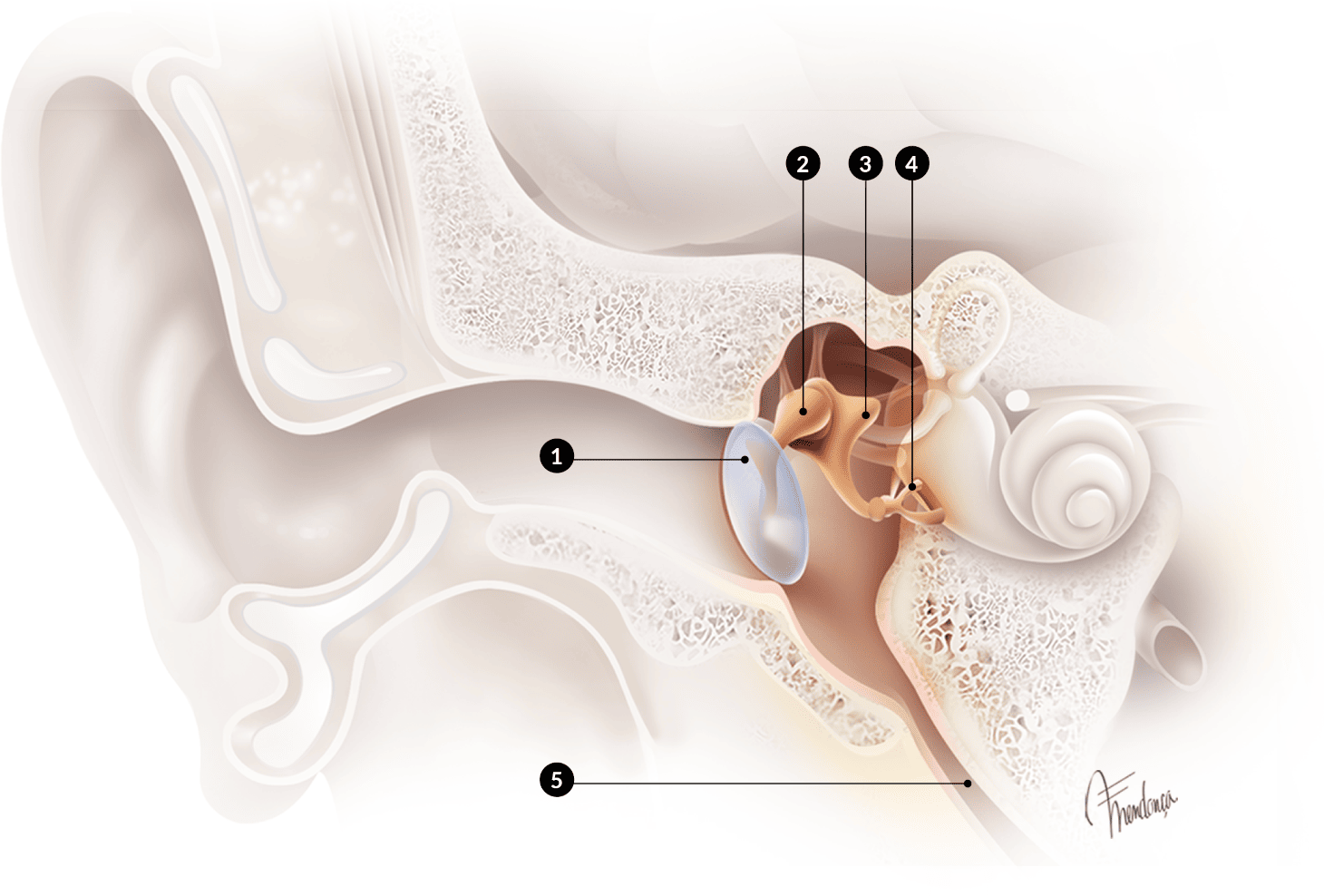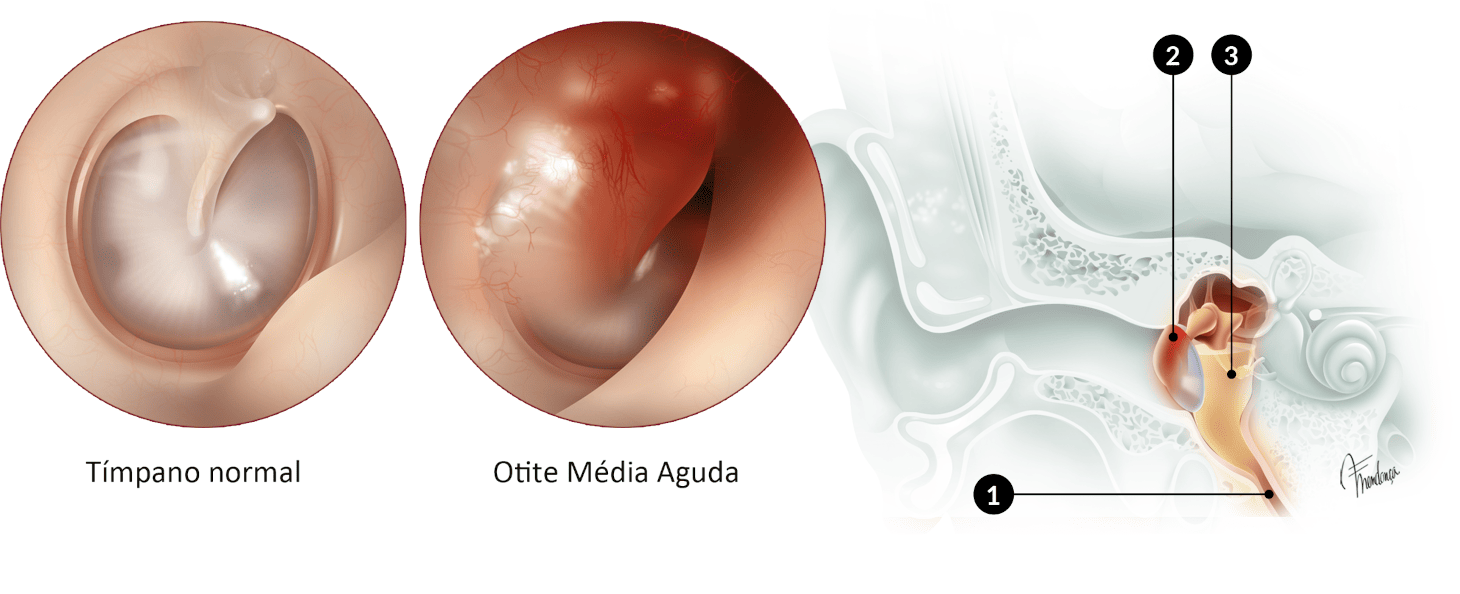Acute Otitis Media
WHAT IS IT?
Acute otitis media is an infection of the mucous membrane of the middle ear, usually caused by bacteria with the presence of exudate (pus)1.
The peak incidence occurs in the first 3 years (mainly between 6 and 24 months) and is less frequent after that age, particularly in young people and adults1.
The middle ear is limited externally by the tympanic membrane and is made of the tympanic cavity, the ossicular chain - malleus, incus and stapes - and a narrow canal located anteriorly, called the Eustachian tube, which communicates with the back of the nose and plays a very important role in normalising pressures inside the ear and draining mucus from the middle ear2 (Fig. 1).

https://otosurgeryatlas.stanford.edu/otologic-surgery-atlas/surgical-anatomy-of-the-ear/
ARE THERE PREDISPOSING FACTORS FOR OTITIS MEDIA?
There are several factors that predispose to otitis media1:
- Upper respiratory viral infections
- Allergy, allergic rhinosinusitis
- Repeated adenoiditis
- Cleft palate
- Patent eustachian tube
- Immunodeficiency
- Continued exposure to microorganisms and pollutant substances in nursery
WHAT ARE THE SIGNS AND SYMPTOMS?
Otitis media includes symptoms of varying intensity1,3-5:
- Intense pain in the ear
- Fever
- Decreased hearing
- Purulent fluid coming out of the ear (otorrhoea, when tympanic perforation occurs)
- Irritability, apathy, loss of appetite, fever and diarrhoea (in children <1 year)
Objective examination:
- Swelling and redness of the tympanic membrane
- Presence of purulent exudate in the ear canal and/or tympanic cavity (Fig.2)

https://otosurgeryatlas.stanford.edu/otologic-surgery-atlas/surgical-anatomy-of-the-ear/
HOW IS ACUTE OTITIS MEDIA TREATED?
Bacteria predominate in otitis externa6:
- Staphilococcus aureus (11-34%)
- Pseudomonas aeruginosa (22-62%)
- Staphilococcus epidermidis
- Corynebacteria
Otitis media acute is treated by the doctor after observation, using antibiotics when necessary and pain treatment4-6:
- amoxicillin is the usual antibiotic of choice
- alternatives: Amoxicillin-clavulanic acid, macrolides (azithromycin and clarithromycin), oral cephalosporins (e.g. cefuroxime axetil)
- in the presence of pus in the ear canal, drops with a combination of antibiotic and corticoid can be used
- pain treatment: paracetamol or ibuprofen
1. Kelvin Kong and Harvey L C Coates, Natural history, definitions, risk factors and burden of otitis media. Med J Aust 2009; 191 (9): S39. || doi: 10.5694/j.1326-5377.2009.tb02925.x Published online: 2 November 2009
2. Dr. Jackler and Ms. Gralapp https://otosurgeryatlas.stanford.edu/otologic-surgery-atlas/surgical-anatomy-of-the-ear/ consultado em 16-11-23
3. Jerome O. Klein, Otitis Externa, Otitis Media, and Mastoiditis, Mandell, Douglas, and Bennett’s Principles and Practice of Infectious Diseases. 2015 : 767– 773.e1. Published online 2014 Oct 31. doi: 10.1016/B978-1-4557-4801-3.00062-X Published online 2019 Mar 29. doi: 10.3238/ arztebl.2019.0224 Continuing Medical Education
Paço, J. et al, Manual de urgências ORL, 2ª edição, 2015, Ed. Bial, 14-15.
5. Paço, J. et al, Otites na prática clínica, Guia de diagnóstico e tratamento, 1ª edição 2010, Ed. José de Mello Saúde,29-30
6. Subtil J., Araújo J.P., Otite Média Aguda, in Otorrinolaringologia Pediátrica, Coordenadores João Subtil, Luisa Monteiro, Edição Círculo Médico, 2016.
